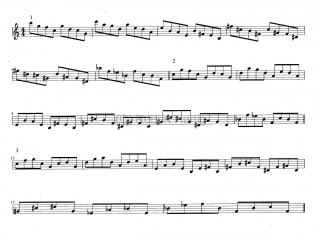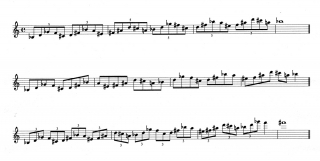This post begins with a slice of my life. Blogs are personal things, or have the capacity to be if we let them. Sometimes I choose to do so in a way that goes beyond the realm of storms and music to other aspects of my world. Today, the pressures of that world have been getting me down. In the face of Michigan’s gnarly economy, the bills have been coming in with a consistency that the amount of business I need in order to pay them has not. As a self-employed copywriter and marketing copyeditor, I’m grateful for every project that I get. Still, as anyone who has felt the bite of this recession can tell you, sometimes it’s hard to stay upbeat. I need more marketing clients. Yoo-hoo…anyone…?
Shameless, aren’t I. But…I’ve learned–or rather, I continue to learn daily–to thank the Lord for small but important glints of progress. One of them lately has been with my book of licks and patterns for Coltrane changes, The Giant Steps Scratch Pad. A number of you have been good enough to buy it–enough of you over this past month in particular that I think the book may be starting to slowly catch on. It was a labor of love, and I hope you’re finding it to be every bit as useful as I envisioned it would be. If you feel inclined to share your experience with it so far, by all means drop a comment. And if you like the book, please spread the word.
Okay, enough of this self-indulgent stuff. August has been a busy month for me, occupied with family and, last weekend, with getting my first and probably last taste of a hurricane as Irene slammed through North Carolina. That’s material for another post soon to come. Overall, in the midst of my preoccupations, I haven’t been updating this blog as often as I normally do. So today, I’m back for you jazz musicianly sorts with an exercise on fourth patterns. Three exercises, actually, with the latter two being variations of the first. Click on the image below to enlarge it.
Note that these patterns cycle downward not by the usual root movement of a perfect fifth, but by perfect fourths. Why is that, you ask. Because I like how it sounds, and you will, too.
These patterns can be used in a number of ways. Since they’re closely related to the pentatonic scale–pick any three adjacent patterns, crunch the notes together, and you’ll have a pentatonic–you can use them as you would pentatonic scales.
For that matter, you can use as many as five of these patterns in succession within a given key and remain diatonic to the key. The fifth pattern will fill in the last blank, furnishing you with all seven notes in that key. For example, the first two-and-a-half bars of the exercise are all diatonic to the key of C major.
From there, the harmonic applications can get as sophisticated as you care to go with them. I’ll let you hash out that part. My mission here is simply to give you something to grease your technique with. Have fun! And if you enjoy this post, check out my many more helpful exercises, transcriptions, and articles for jazz improvisers.



